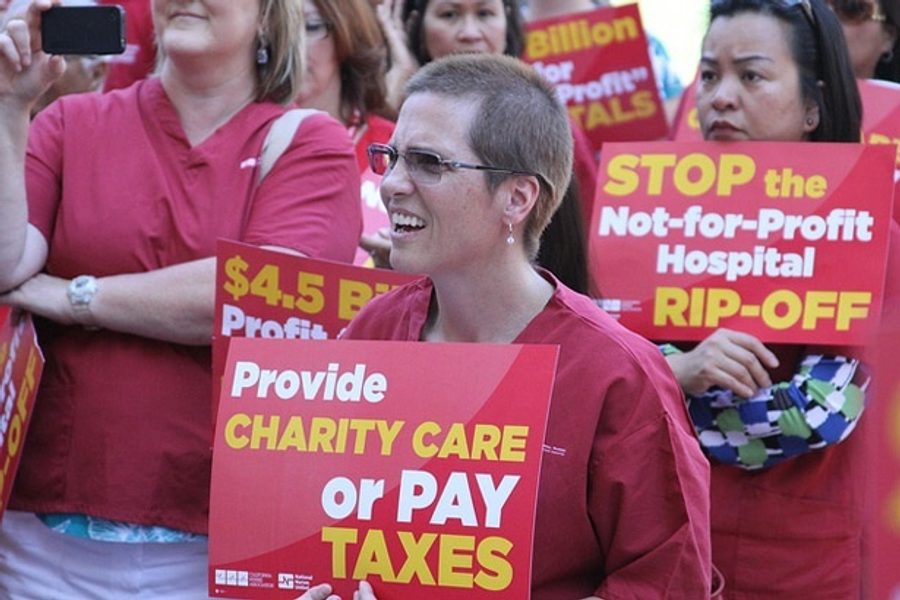
Not-for-profit hospitals, including some of the country’s biggest and best-known institutions, are almost entirely tax exempt, in part because of the expectation they will provide free or low-cost “charity care” to those in need. But a report released this week by a research arm of California Nurses Association / National Nurses United found that California not-for-profit hospitals are reaping huge tax benefits while providing minimal charity care.
Many people don’t realize that not-for-profit institutions can accumulate profits. They can; the profit cannot be disbursed to individual owners or stockholders but rather is supposed to be reinvested for the good of the community. With hospitals, that is generally assumed to include the provision of charity care to uninsured or low-income people. But while 11 states, including Texas and Alabama, mandate specific levels of charity care, California and the federal government do not.
As a result, not-for-profit tax breaks for well-known California hospitals – including Cedars Sinai, Kaiser Permanente and Stanford University – dwarf the level of charity care provided. Overall, the 196 hospitals surveyed received $3.3 billion in 2010 state and federal tax exemptions and spent only $1.4 billion on charity care – a gap of $1.8 billion. Three-quarters of the hospitals got more dollars in tax breaks than they spent on charity care. Half spent less than 2.46 percent of their operating expenses on charity care.
The tax breaks hurt financially strapped counties and towns; according to the report, California counties and municipalities lost about $1 billion in tax revenue they would have otherwise collected in 2010. Public budgets suffer when large institutions don’t pay taxes, and budget crunches are often taken out on public workers, as well as those who rely on the services they provide. Counties or cities also end up essentially picking up the tab for health care when impoverished patients can’t pay and hospitals either deny care – diverting the patients elsewhere – or insist on billing. The report notes that California counties and towns paid $450 million in 2010 to for-profit and not-for-profit hospitals for care for people who could not pay their medical bills.
All of these spillover effects concern National Nurses United, whose mission includes patient advocacy and “accessible, quality healthcare for all.” Spokesperson Chuck Idelson told In These Times, “Nurses see what happens to their patients and their communities when these giant corporate hospitals behave more like Lehman Brothers or JP Morgan than a community service. For example, Sutter Health has engaged in widespread slashing of mental health services, women’s services, children’s services – cuts that will make them profits.”
The nurses’ union proposes California legislation that would force not-for-profit hospitals to beef up their charity care if they want to maintain their tax exemptions. It wants hospitals to spend at least 8 percent of revenues on charity care, echoing a proposal made by the state attorney general in 2006. The nurses are also demanding more transparency in how hospitals report and define their charity care, to exclude the “promotional activities or cost containment (interpreted by many hospitals as cutting services)” that are currently counted. Violations of charity care obligations could be punished by fines and/or the revoking of tax exempt status.
To those who wish to support NNU’s efforts, Idelson says, “You can contact your legislator to insist they pass legislation, and tell the non-profit hospitals to cease their practices of putting profits and executive pay over charity care.”
While California relies more heavily than most states on not-for-profit hospitals, which take in 70 percent of California patients, the nurses union says that similar situations exist nationwide. In 2004 I wrote for the Chicago Reader about the religious, not-for-profit chain Advocate denying charity care to people in need – billing them for their care, and then suing them and garnishing their wages when they couldn’t pay bills that were actually larger than insured people would have been given for the same service.
Earlier this month scores of union nurses, in their trademark red garb, attended the release of a report by the state auditor on charity care. At the hearing, State Board of Equalization member Betty Yee noted that not-for-profit hospitals actually often provide less charity care than for-profit institutions.
Many for-profit hospitals have taken a hit during the economic crisis, in part because of rising numbers of uninsured and desperate patients whom they are legally obligated to treat. (One exception, as The New York Times reported this week, is the HCA chain owned by Bain Capital, which has made huge profits largely through cutting services and staffing.)
Idelson stressed that the debate shouldn’t be about the merits of for-profit versus not-for-profit health care systems, but rather public versus private ones. “If you look at the level of charity care and other community benefits and pricing practices, the difference between private not-for-profit and private for-profit hospitals is very small,” she says. “But the difference between private and public systems is massive. The institutions that are really acting in a way people think hospitals should behave are the hard-pressed county and public hospital systems.”
Idelson noted that while the union’s recommendations are necessary for the immediate future, the overall crisis just underscores the need for revamping the country’s entire private, profit-based health care system.
“No one should have to worry about getting access to medical care. You should not see services arbitrarily cut because they are not profitable services. In the long term the only solution is transforming our healthcare system into the type most countries have – which is a national single-payer system.”
Kari Lydersen is a Chicago-based journalist, author and assistant professor at Northwestern University, where she leads the investigative specialization at the Medill School of Journalism, Media, Integrated Marketing Communications. Her books include Mayor 1%: Rahm Emanuel and the Rise of Chicago’s 99%.








